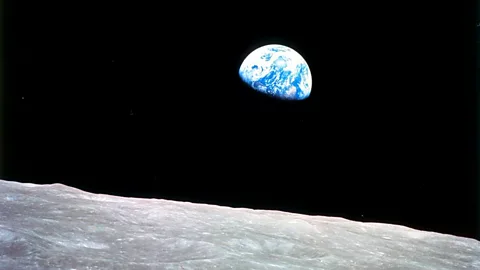The 1968 photo that changed the world
 Nasa
NasaMore than 50 years after it was shot, Earthrise continues to be seen as one of the most iconic environmental photographs ever taken.
On Christmas Eve, 1968 the crew of Apollo 8 captured a spectacular sight as they orbited the Moon: the illuminated Earth appearing above the barren lunar horizon.
The Nasa astronauts were awestruck by what they saw.
"Oh my God, look at that picture over there! There's the Earth coming up. Wow, is that pretty!" Bill Anders shouted at fellow astronaut Jim Lovell. "You got a colour film, Jim? Hand me a roll of colour, quick, would you?"
"That's a beautiful shot," said Lovell as Anders clicked the shutter and captured what has become one of the world's most famous photographs.
The image was coined "Earthrise". It was the first colour photograph of Earth taken from space and quickly circulated around the world. The photo is widely credited with propelling the global environmental movement and leading to the creation of Earth Day, an annual event promoting environmental activism and awareness, in 1970.
You might also like:
More than 50 years after it was shot, Earthrise continues to be seen as one of the most iconic environmental photographs ever taken.
"It's just the perfect image," says Michael Pritchard, programmes director at the Royal Photographic Society in the UK. "It was a colour and good high-resolution image that could be reproduced really well and it provided a perspective of the Earth that had never been seen before."
"It clearly showed the Earth from space but also put it into a context that we hadn't seen before," he says. "It showed that Earth was this very vulnerable sphere in space."
In the late 1960s, environmental perspectives and activism were rapidly sweeping across the United States and Europe. The environmental groups Friends of the Earth and Greenpeace were founded in 1969 and 1971, respectively. The US government established the Environmental Protection Agency in 1970.
Eighteen months after the Apollo 8 astronauts shot Earthrise, 20 million people took to the streets across the US to protest environmental destruction in the first ever Earth Day.
Carbon Count
The emissions from travel it took to report this story were 0kg CO2. The digital emissions from this story are an estimated 1.2g to 3.6g CO2 per page view. Find out more about how we calculated this figure here.
Kathleen Rogers, president of the Earth Day Network, says the Earthrise photo played a pivotal role in encouraging people to take part in environmental activism.
"It gave rise to Earth Day, which now has a billion people participating, and created an environmental movement worldwide," says Rogers. The posters for Earth Day in 1970 all featured the Earthrise photo, she says. (Read more about how the first Earth Day helped to create an environmental movement).
Before Earth Day, people talked about how space exploration had made it far clearer how unique we are, adds Rogers. "Once the photo was published, members of Congress and global leaders all started talking about how fragile the Earth was. Earthrise highlighted the uniqueness of Earth in that big black universe and it drove home to millions of people how dirty our planet was."
Pritchard adds that images such as the Earthrise photo can say far more "than pages and pages of reports" from environmental organisations.
"[It highlighted] that the Earth is not something that we can continually take from, that we have to preserve it," he says. "That's where Earthrise's real strength and importance lies…it was able to sum up so much in just a single image in a way that transcended documents and papers."
Because of its history and powerful message, the Earthrise photo continues to ignite environmental awareness.
"It shows the Earth that we all live on, a little blue sphere set within this black expanse," says Pritchard. "It suggests everything from fragility to our uniqueness."
* This article was originally published on 12 May 2023.
--
